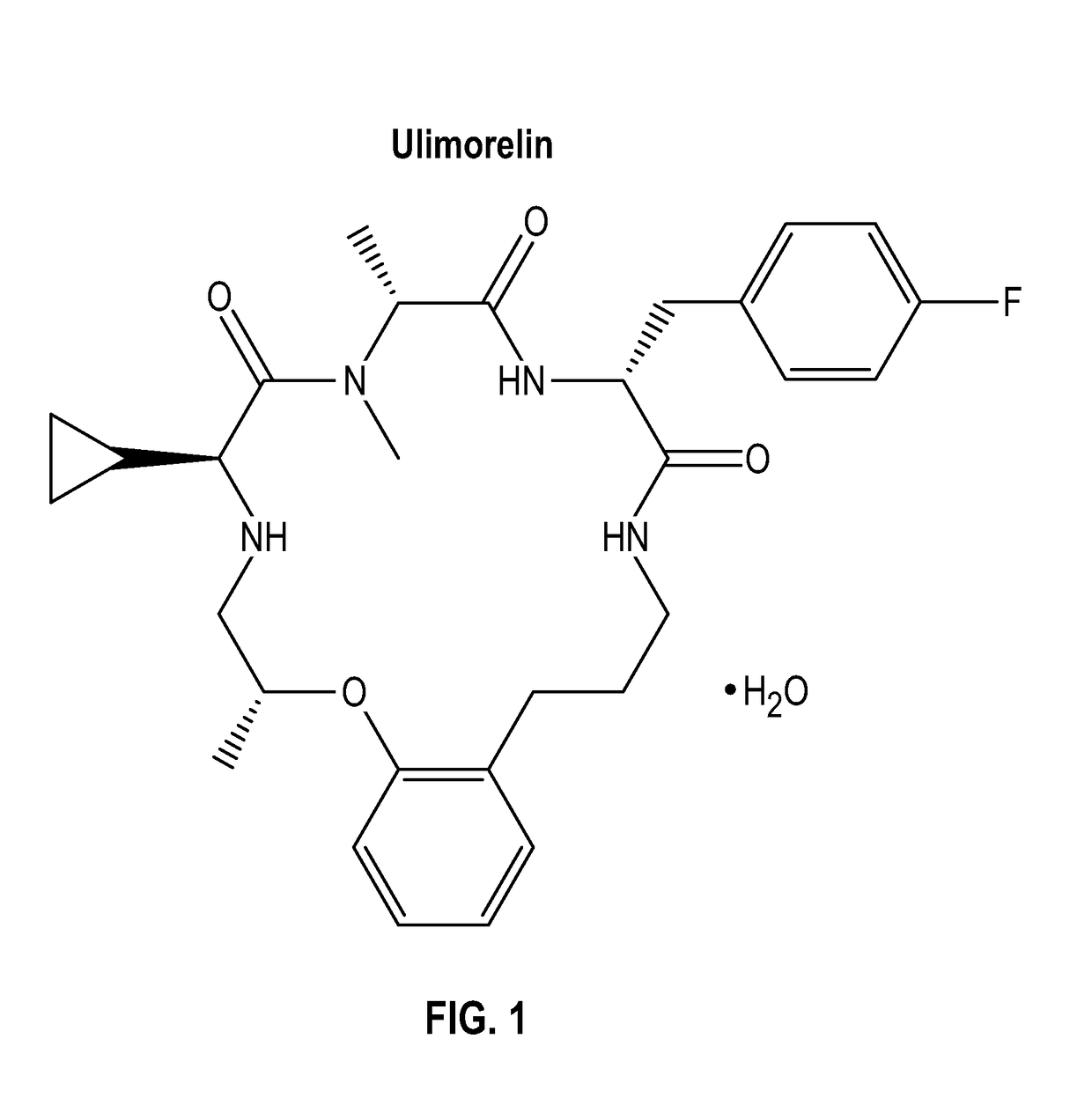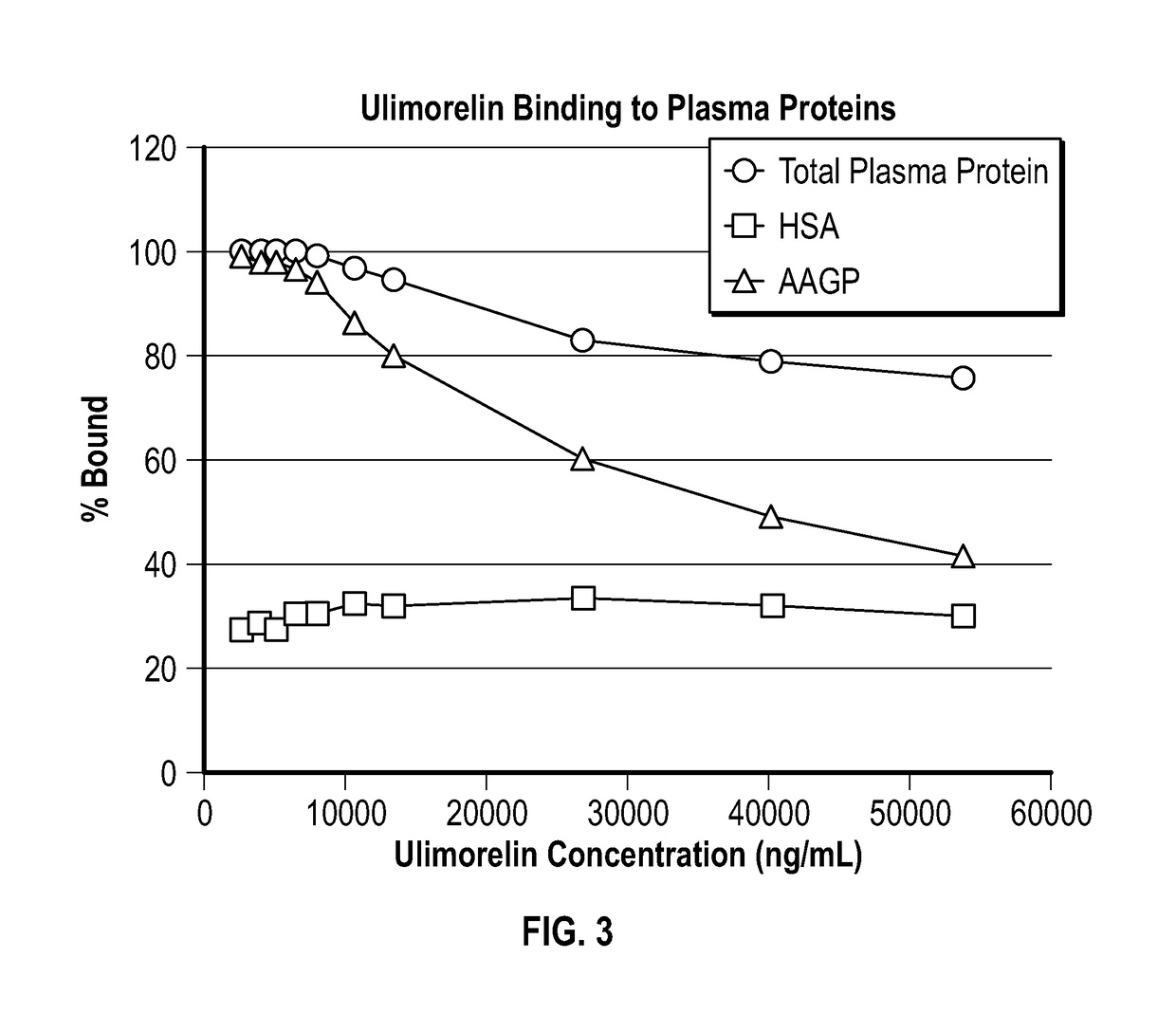Treatment of enteral feeding intolerance
- Summary
- Abstract
- Description
- Claims
- Application Information
AI Technical Summary
Benefits of technology
Problems solved by technology
Method used
Image
Examples
example 1
Human Ghrelin Release
[0098]Endogenous ghrelin blood levels are pulsatile. Ghrelin rises sharply prior to eating and declines post-prandially. This happens about three times a day in healthy individuals (see Cummings et al., Diabetes 50:1714-1719, 2001). With reference to FIG. 2, average plasma ghrelin concentrations over a 24 hour period in 10 human subjects consuming breakfast, lunch, and dinner is shown. Plasma samples were collected and tested at the time indicated by dashed lines, namely, 0800, 1200, and 1730 [FIG. 2 adapted from: A Preprandial Rise in Plasma Ghrelin Levels Suggests a Role in Meal Initiation in Humans, Cummings et al., supra].
example 2
Binding to AAGP
[0099]As shown in Table 1 and FIG. 3, ulimorelin is extensively bound (approximately 95 to 99%) to human plasma proteins at concentrations at and below 15 μM, which encompasses the plasma concentrations observed in the clinic. AAGP was identified as the major binding protein for ulimorelin in human plasma, with human serum albumin (HSA) being a minor contributor to the overall plasma protein binding. In vitro, the fraction of ulimorelin bound to AAGP ranged from >99% to <50% at ulimorelin concentrations ranging from 5 to 100 uM and at an AAGP concentration of 1 mg / mL, representative of the normal range in healthy humans. The fraction of ulimorelin bound to HSA was approximately 30% and was independent of ulimorelin concentration across the concentration range (5-100 μM) tested.
TABLE 1Ulimorelin Binding to Total Plasma Proteins,Purified Human Alpha 1-Acid Glycoprotein (1000μg / mL AAGP), and Albumin (4% w / v HSA).% Bound1000Ulimorelinμg / mL(uM)Total PPBAAGP4% HSA599.899.72...
example 3
Adjusting Dose by AAGP Level
[0100]This example illustrates methods of the invention in which an EFI patient's serum AAGP concentration (level) is measured and used to adjust dosing of ulimorelin based on a target Cpfree. Cpfree at Tmax (Cmaxfree) was determined to be about 10-25 ng / mL at 600 μg / mL from dialysis studies of plasma from healthy volunteers enrolled in the Thorough QT (TQT) study (Table 2 and FIG. 4), so 20 ng / mL is used here as a theoretical target Cpfree (actual value can be determined in clinical studies in an EFI population). Because the free fraction is dependent on the ratio of total drug to AAGP levels, the total dose can be adjusted to maintain the desired ratio, and thus Cpfree. The theoretical plot in FIG. 5 illustrates that dose varies linearly with AAGP concentrations for a given Cpfree. In this “ideal” example, the factor to adjust dose is: Dose (μg / kg)=0.6*[AAGP (μg / mL)]. This is just an example; the actual relationship can be determined by clinical studies...
PUM
| Property | Measurement | Unit |
|---|---|---|
| Density | aaaaa | aaaaa |
| Density | aaaaa | aaaaa |
| Dimensionless property | aaaaa | aaaaa |
Abstract
Description
Claims
Application Information
 Login to View More
Login to View More - R&D
- Intellectual Property
- Life Sciences
- Materials
- Tech Scout
- Unparalleled Data Quality
- Higher Quality Content
- 60% Fewer Hallucinations
Browse by: Latest US Patents, China's latest patents, Technical Efficacy Thesaurus, Application Domain, Technology Topic, Popular Technical Reports.
© 2025 PatSnap. All rights reserved.Legal|Privacy policy|Modern Slavery Act Transparency Statement|Sitemap|About US| Contact US: help@patsnap.com



